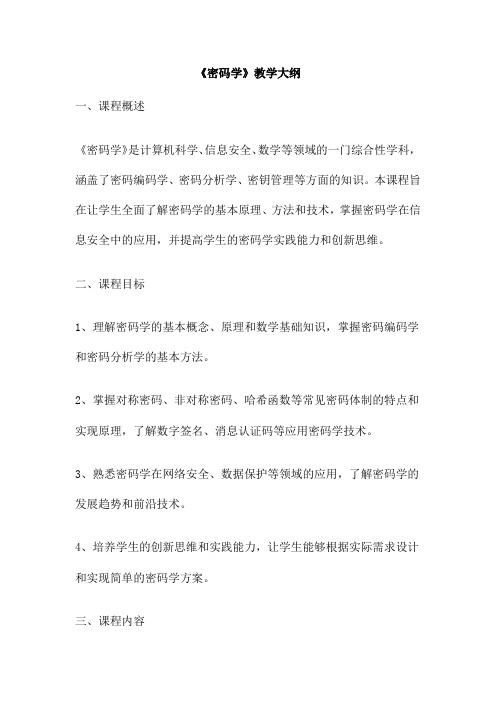格密码学课程三
高中数学选修5-3(密码学算法基础) 选修课密码学3 课件

1.2 模运算 同余有以下性质: ① 若n|(a-b),则a≡b mod n。(试证明) ② (a mod n)≡(b mod n),则a≡b mod n。 ③ a≡b mod n,则b≡a mod n。 ④ a≡b mod n,b≡c mod n,则a≡c mod n。 从以上性质易知,同余类中的每一元素都可作为这 个同余类的表示元素。
10
1.2 模运算
① 交换律 (w+x) mod n=(x+w) mod n (w×x) mod n=(x×w) mod n ② 结合律 [(w+x)+y] mod n=[w+(x+y)] mod n [(w×x)×y] mod n=[w×(x×y)] mod n ③ 分配律 [w×(x+y)] mod n=[w×x+w×y] mod n ④ 单位元 (0+w) mod n=w mod n (1×w) mod n=w mod n ⑤ 加法逆元 对w∈Zn,存在z∈Zn,使得 w+z≡0 mod n,记z=-w。
a p1 p2 pt
91=13 ×7 ,11011=13 ×112 ×7 这一性质称为算术基本定理。
1
2
t
其中p1>p2>…pt是素数,ai>0(i=1,…,t)。例如
这一性质也可表示为:
4
a p
pP
ap
1.1 素数和互素数
两数相乘等价于这两个数的分解式中相同因子的指数 相加,即由k=mn 可得:对每一素因子p, kp=mp+np 2 3 例如: m 54 32 n 5 3 2
3
6 1 4 7 2 5
4
0 4 0 4 0 4
密码学3 序列密码PPT共71页

密码学3 序列密码
1、最灵繁的人也看不见自己的背脊。——非洲 2、最困难的事情就是认识自己。——希腊 3、有勇气承担命运这才是英雄好汉。——黑塞 4、与肝胆人共事,无字句处读书。——周恩来 5、阅读使人充实,会谈使人敏捷,写作使人精确。——培根
ቤተ መጻሕፍቲ ባይዱ
6、法律的基础有两个,而且只有两个……公平和实用。——伯克 7、有两种和平的暴力,那就是法律和礼节。——歌德
8、法律就是秩序,有好的法律才有好的秩序。——亚里士多德 9、上帝把法律和公平凑合在一起,可是人类却把它拆开。——查·科尔顿 10、一切法律都是无用的,因为好人用不着它们,而坏人又不会因为它们而变得规矩起来。——德谟耶克斯
密码破译教案设计——小学四年级数学课《推理格子密码》

密码破译教案设计——小学四年级数学课《推理格子密码》引言密码在我们日常生活中扮演着重要的角色,以确保我们的个人信息和财产的安全。
密码学是一个古老而优雅的学科,涉及加密和解密技术。
通过数学推理,我们可以破译复杂的密码。
在小学四年级数学课上,教学内容特别注重数学推理能力的培养。
为此,我们设计了一节推理格子密码的课程,以帮助学生更好的理解密码学。
一、课程目标本节课的主要目标是:让学生了解密码学的基本原理,了解密码的基本构成、特点和类型,掌握基本的密码破译技巧。
二、教学准备教学工具:黑板、彩色粉笔、白纸、彩笔。
教学材料:推理格子密码题目(见附录)。
三、教学内容1.密码学介绍教师引入密码学的基本概念,阐释密码学在我们日常生活中的重要性,介绍一些密码学的基本原理和术语。
2.密码的构成和特点教师介绍密码的基本构成,即明文、密文和密钥,以及密码的特点,包括保密性、不可逆性和鉴别性。
3.推理格子密码教师引入推理格子密码,让学生了解并尝试破译该密码。
(1)教师将推理格子密码题目投影到黑板上,并让学生观察和分析该密码。
(2)教师让学生通过简单的推理和计算方法,破解推理格子密码。
(3)教师引导学生思考推理格子密码的特点,同时加深他们对密码破译方法的理解。
4.小结教师总结本节课讲解的内容和重点,强调密码破译技巧的重要性,并鼓励学生在以后的学习和生活中灵活运用所学的密码破译技巧。
四、教学方式本课程采用讲解与实践相结合的方式,教师在授课的同时,也将学生引导到实际操作中,通过推理和计算来破译密码。
这样,既保障了教学效果的着重,也使得教学内容更加生动有趣。
五、教学评估学生在课堂上表现积极,能够积极地参与讨论和实践操作。
教师可以通过观察学生的课堂表现和完成的题目,来评估他们的掌握情况和理解程度。
同时,教师也应该重视学生对所学内容的反馈和意见。
六、拓展延伸教师可以鼓励学生自行寻找其他推理格子密码的题目,并在课堂上共同解析破译方法。
同时,教师也可以探讨其他类型的密码及其破译方法,进一步加深学生对密码学的理解。
lattice cryptography基础——格密码学前置知识

lattice cryptography基础——格密码学前置知识
格密码学(Lattice Cryptography)是一种基于数学格的加密方法,其安全性依赖于数学格的困难问题。
在了解格密码学之前,需要掌握以下前置知识:
1.线性代数:格密码学的基础是数学格,而数学格是线性代数
中的一个重要概念。
因此,了解向量、矩阵、线性方程组等基本概念对于理解格密码学至关重要。
2.抽象代数:格密码学涉及到的加密算法通常基于抽象代数中
的群、环、域等概念。
掌握这些概念有助于理解格密码学的原理。
3.密码学基本概念:了解密码学的基本概念,如明文、密文、
加密算法、解密算法、密钥等,有助于理解格密码学的应用场景。
4.数值计算方法:在实际应用中,格密码学涉及到的计算问题
通常需要借助数值计算方法。
例如,求解格中最短向量等问题。
5.随机化算法:格密码学中的加密和解密算法通常涉及到随机
化过程。
了解随机化算法的基本原理有助于理解这些算法的性能。
当掌握了以上前置知识后,就可以进一步学习格密码学的具体算法和应用。
密码学专业主干课程

密码学专业主干课程摘要:一、引言二、密码学概述1.密码学定义2.密码学发展历程三、密码学专业主干课程1.密码学基础课程2.密码学进阶课程3.密码学应用课程四、课程举例与介绍1.密码学基础课程举例与介绍2.密码学进阶课程举例与介绍3.密码学应用课程举例与介绍五、结论正文:【引言】密码学是一门研究信息加密与解密、保证信息安全的学科,随着信息化时代的到来,密码学在信息安全、电子商务等领域具有重要的应用价值。
密码学专业因此应运而生,培养具备密码学理论基础和实践能力的高级人才。
本文将介绍密码学专业的主干课程,以帮助大家了解该专业的学习内容。
【密码学概述】密码学是研究加密与解密方法、破译与防护手段的一门学科。
其发展历程可追溯到古代的密码传递,如古希腊的斯巴达加密法。
随着科技的发展,现代密码学涉及到数字、编码、序列、图像等多个领域。
【密码学专业主干课程】密码学专业主干课程可以分为三类:密码学基础课程、密码学进阶课程和密码学应用课程。
【密码学基础课程】密码学基础课程主要包括:1.数学基础:高等数学、线性代数、概率论与数理统计等。
2.计算机科学基础:计算机原理、数据结构、算法分析等。
3.密码学基础:密码学原理、对称加密、非对称加密、哈希函数等。
【密码学进阶课程】密码学进阶课程主要包括:1.密码学分支:分组密码、序列密码、公钥密码、量子密码等。
2.安全协议:身份认证、加密协议、签名协议等。
3.密码学理论:信息论、复杂度理论、密码学数学基础等。
【密码学应用课程】密码学应用课程主要包括:1.网络安全:网络攻防、入侵检测、安全体系结构等。
2.应用密码学:数字签名、电子商务、移动通信安全等。
3.密码学实践:密码学实验、密码算法实现、安全系统设计等。
【课程举例与介绍】【密码学基础课程举例与介绍】1.高等数学:为密码学提供必要的数学基础,如代数、微积分等。
2.密码学原理:介绍密码学基本概念、加密解密方法等。
【密码学进阶课程举例与介绍】1.分组密码:研究将明文分成固定长度组进行加密的方法。
《密码学》教学大纲

《密码学》教学大纲一、课程概述《密码学》是计算机科学、信息安全、数学等领域的一门综合性学科,涵盖了密码编码学、密码分析学、密钥管理等方面的知识。
本课程旨在让学生全面了解密码学的基本原理、方法和技术,掌握密码学在信息安全中的应用,并提高学生的密码学实践能力和创新思维。
二、课程目标1、理解密码学的基本概念、原理和数学基础知识,掌握密码编码学和密码分析学的基本方法。
2、掌握对称密码、非对称密码、哈希函数等常见密码体制的特点和实现原理,了解数字签名、消息认证码等应用密码学技术。
3、熟悉密码学在网络安全、数据保护等领域的应用,了解密码学的发展趋势和前沿技术。
4、培养学生的创新思维和实践能力,让学生能够根据实际需求设计和实现简单的密码学方案。
三、课程内容第一章密码学概述1、密码学的定义和历史发展2、密码学的应用领域和重要性3、密码学的分类和基本概念第二章密码编码学基础1、对称密码体制和非对称密码体制的特点和原理2、哈希函数和数字签名的概念和应用3、加密算法的设计原则和评估指标第三章对称密码体制1、数据加密标准(DES)的原理和应用2、国际数据加密算法(IDEA)的原理和应用3、分组密码和流密码的特点和实现方法第四章非对称密码体制1、RSA算法的原理和应用2、ElGamal算法和Diffie-Hellman密钥交换的原理和应用3、椭圆曲线密码学的原理和应用第五章哈希函数和数字签名1、SHA-1、SHA-256等常见哈希函数的原理和应用2、RSA数字签名算法的原理和应用3、其他数字签名方案的原理和应用,如DSA、ECDSA等第六章应用密码学技术1、数字证书和PKI系统的原理和应用2、消息认证码(MACs)和完整性校验算法的原理和应用3、零知识证明和身份基加密方案的概念和应用第七章密码分析学基础1、密码分析学的定义和重要性2、密码分析的基本方法和技巧,如统计分析、频率分析、差分分析等3、对称密码分析和非对称密码分析的特点和难点第八章密码管理基础1、密钥管理的概念和原则,如密钥生成、分发、存储、使用和销毁等2、密钥管理技术在企业和个人中的应用,如公钥基础设施(PKI)、加密磁盘等3、密码政策和安全意识教育的重要性。
密码学教学大纲

密码学教学大纲一、课程名称密码学(Cryptology)二、课堂授课学时与学分学时:54学分:3三、授课对象信息安全专业3年级本科生四、先修课程高级语言程序设计、信息安全数学基础、计算机原理、通信原理五、教学目的随着计算机和计算机网络在军事、政务、金融、商业等部门的广泛应用,社会对计算机的依赖越来越大,如果计算机系统的安全受到破坏将导致社会的混乱并造成巨大损失。
然而,目前敌对势力的破坏、计算机病毒泛滥、黑客入侵、利用计算机犯罪等危害计算机系统安全的现状是十分严重的。
因此,确保计算机系统的安全已成为世人关注的社会问题并成为计算机科学的热点研究课题。
我国政府十分重视信息安全技术和产业的发展,并把它列入我国优先发展的领域。
密码技术是信息安全的关键技术之一。
密码技术是一门古老的技术,大概自人类社会出现战争便产生了密码。
战争和科学技术的进步推动了密码学的发展。
计算机和计算机网络的广泛应用,电子政务、电子商务的发展给密码学开拓了广泛的应用空间,从而使密码学进入了空前繁荣的阶段。
本课程讲授密码学的基本理论和基本应用技术。
七、主要内容、基本要求、实验内容及学时分配主要内容:1、概论:信息安全的概念。
2、密码学的基本概念:密码学的基本概念,古典密码,古典密码的统计分析。
3、分组密码:数据加密标准(DES),高级数据加密标准(AES),我国商用密码SMS4,分组密码的应用技术。
4、序列密码:序列密码的概念,线性移位寄存器密码,非线性序列密码,有限状态自动机密码,RC4密码。
5、公开密钥密码:公开密钥密码的概念,RSA密码,ELGamal密码,ECC密码。
6、数字签名:数字签名的概念,利用公开密钥密码实现数字签名,美国数字签名标准(DSS)。
7、认证:认证的概念,站点认证,报文认证,身份认证。
8、密钥管理:密钥管理的概念,传统密码的密钥管理,公开密钥密码的密钥管理,公开密钥基础设施(PKI)。
基本要求:本课程主要讲授密码学的基本理论、一些有代表性的密码体制以及密码的应用技术,因此要求学生通过本课程的学习掌握密码学的基本理论和基本应用技术。
《密码学》课程大纲

《密码学》课程大纲执笔张焕国1、课程代码:2、课程名称:《密码学》英文名称:Cryptology3、授课对象:信息安全专业本科学生4、学分:35、课程类型:必修课程6、课程负责人:张焕国,杜瑞颖,唐明,王张宜,王后珍6、先修课程:《信息安全导论》,《信息安全数学基础》,《程序设计》7、实践课程:《密码学课程设计》8、考试方式:平时考查与期末考试相结合9、授课时数:54学时10、学习目的:密码学由密码编制学和密码分析学组成。
密码编制学研究编制高质量密码的理论与技术,密码分析学研究分析和破译密码的理论和技术。
这两者相辅相成,共同组成密码学。
密码学是信息安全学科的重要组成部分,密码技术是信息安全领域的关键技术。
密码学的知识和实践能力是《信息安全专业指导性专业规范》中规定的必修内容。
因此,《密码学》在信息安全专业中是必修课程。
通过《密码学课程》的教学,使学生掌握密码学的基本知识、基本理论和基本技术。
通过配套的实验课程《密码学课程设计》的教学,使学生掌握密码学的基本实践能力。
这样,通过《密码学课程》和《密码学课程设计》的教学,为学生今后的工作和进一步学习,奠定密码学的理论和实践基础。
11、课程内容:1. 密码学的概念⏹密码学的概念⏹密码体制⏹古典密码⏹密码安全性2. 分组密码⏹分组密码的概念⏹DES⏹AES⏹中国商用密码SMS4⏹分组密码工作模式3. 流密码⏹流密码的概念⏹线性移位寄存器序列⏹非线性序列⏹伪随机序列评价⏹典型流密码,如祖冲之密码或RC4密码4. Hash 函数⏹Hash 函数的概念⏹SHA 系列Hash 函数⏹中国商用密码Hash 函数SM3⏹HMAC5. 公钥密码⏹公钥密码的概念⏹RSA 密码⏹ElGamal 密码⏹椭圆曲线密码(包括中国商用密码SM2)6. 数字签名⏹数字签名的概念⏹RSA 密码数字签名⏹ElGamal 密码数字签名⏹椭圆曲线密码数字签名(包括中国商用密码SM2的数字签名)⏹盲签名7. 认证⏹认证的概念⏹身份认证⏹站点认证⏹报文认证⏹密码协议的概念⏹密码学协议的安全性8. 密钥管理⏹密钥管理的概念⏹对称密码的密钥管理⏹公钥密码的密钥管理⏹公钥基础设施PKI9. 密码应用(至少讲授其中一个应用)⏹计算机文件加密⏹通信加密⏹可信计算中的密码应用⏹电子商务应用12、教材:张焕国,王张宜,《密码学引论》第二版,武汉大学出版社,2009。
- 1、下载文档前请自行甄别文档内容的完整性,平台不提供额外的编辑、内容补充、找答案等附加服务。
- 2、"仅部分预览"的文档,不可在线预览部分如存在完整性等问题,可反馈申请退款(可完整预览的文档不适用该条件!)。
- 3、如文档侵犯您的权益,请联系客服反馈,我们会尽快为您处理(人工客服工作时间:9:00-18:30)。
bi
2
> µi,i+1 bi + bi+1 2 ,
The idea behind the SizeReduce(B) subroutine is, in the Gram-Schmidt decomposition B = B · U, to shift the entries in the upper triangle of U by integers (via unimodular transformations), so that they lie in 1 [− 1 2 , 2 ). Because changing an entry of U may affect the ones above it (but not below it) in the same column, we must make the changes upward in each column. Formally, the algorithm works as follows: • For each j = 2, . . . , n (in any order) and i = j − 1 down to 1, let bj ← bj − µi,j · bi , where µi,j = bj , bi / bi , bi is the (i, j )th entry of the upper-unitriangular matrix in the Gram-Schmidt decomposition of the current basis B. (Note that previous iterations can change this matrix.) In matrix form, in the (i, j )th iteration we are letting B ← B · W, where W is the upper unitriangular matrix with just one potentially nonzero off-diagonal entry − µi,j , at position (i, j ). We make a few important observations about the SizeReduce algorithm. First, it clearly runs in time polynomial in the bit length of the input basis B. Second, even though B may change, the Gram-Schmidt vectors B are preserved throughout, because the only changes to B are via multiplication by upper-unitriangular matrices, i.e., if B = B · U is the Gram-Schmidt decomposition prior to some iteration, then B = B · (UW) is the decomposition afterward, since UW is upper unitriangular. Finally, the (i, j )th iteration ensures that 1 the value bj , bi / bi , bi ∈ [− 1 2 , 2 ) (by definition of µi,j ), and following the iteration, that value never changes, because bk is orthogonal to bi for all k < i. (This is why it important that we loop from i = j − 1 down to 1; bk may not be orthogonal to bi for k > i.) Putting these observation together, we have the following lemma on the correctness of SizeReduce. Lemma 1.2. Given an integral basis B ∈ Zn×n with Gram-Schmidt decomposition B = B · U, the SizeReduce algorithm outputs a basis B of L = L(B) having Gram-Schmidt decomposition B = B · U , 1 where every entry ui,j for i < j is in [− 1 2 , 2 ). We now state the main theorem about the LLL algorithm. Theorem 1.3. Given an integral basis B ∈ Zn×n , the LLL algorithm outputs an LLL-reduced basis of L = L(B) in time poly(n, |B|), where |B| denotes the bit length of the input basis. 1
The remainder of this section is dedicated to an (almost complete) proof of this theorem. First, it is clear that the LLL algorithm, if it ever terminates, is correct: all the operations on the input basis preserve the lattice it generates, and the algorithms terminates only when the basis is LLL-reduced. We next prove that the number of iterations is O(N ) for some N = poly(n, |B|). This uses a clever “potential argument,” which assigns a value to all the intermediate bases produced by the algorithm. We show three facts: that the potential starts out no larger than 2N , that it never drops below 1, and that each iteration of the algorithm decreases the potential by a factor of at least 4/3 > 1. This implies that the number of iterations is at most log√4/3 2N = O(N ). The potential function is defined as follows: for a basis B = (b1 , . . . , bn ), let Li = L(b1 , . . . , bi ) for each 1 ≤ i ≤ n. The potential is the product of these lattices’ determinants:
n Proof. The potential of the original basis B is clearly bounded by n ≤ maxi bi n = 2poly(n,|B|) . i=1 bi Every intermediate basis is integral and has positive integer determinant, hence so do the lattices Li associated with that basis. Therefore, the potential of that basis is at least 1.
n n n
Φ(B) :=
i=1
det(Li ) =
i=1
b1 · · · bi
=
i=1
bi
n−i+1
.
Claim 1.4. The potential of the initial input basis B is at most 2N where N = poly(n, |B|), and every intermediate basis the algorithm produces has potential at least 1.
2
We next analyze how the potential changes when we perform a swap in Step 3. Claim 1.5. Suppose bi and bi+1 are swapped in Step 3, and let the resulting basis be denoted B . Then bj = bj for all j ∈ {i, i + 1}, and bi = µi,i+1 bi + bi+1 . Proof. For j < i, the vector bj is unaffected by the swap, because by definition it is the component of bj = bj orthogonal to span(b1 , . . . , bj −1 ) = span(b1 , . . . , bj −1 ). Similarly, for j > i + 1, the vector bj is the component of bj = bj orthogonal to span(b1 , . . . , bj −1 ) = span(b1 , . . . , bj −1 ), where the equality holds because both bi and bi+1 are in the span. Finally, bi is the component of bi = bi+1 orthogonal to span(b1 , . . . , bi−1 ) = span(b1 , . . . , bi−1 ), which is µi,i+1 bi + bi+1 by construction. Lemma 1.6. Suppose bi and bi+1 are swapped in Step 3, and let the resulting basis be denoted B . Then Φ(B )/Φ(B) < 3/4. Proof. Let Li = L(b1 , . . . , bi−1 , bi ) and Li = L(b1 , . . . , bi−1 , bi+1 ). By Claim 1.5, we have b1 · · · bi−1 µi,i+1 bi + bi+1 µi,i+1 bi + bi+1 Φ(B ) det(Li ) = = = < Φ(B) det(Li ) b1 · · · bi−1 bi bi where the last inequality follows from the Lov´ asz condition. This completes the proof that the number of iterations is O(N ) = poly(n, |B|). Moreover, each iteration of the algorithm is polynomial time in the bit length of the current basis. However, this does not necessarily guarantee that the LLL algorithm is polynomial time overall, since the bit length of the intermediate bases could increase with each iteration. (For example, if the bit length doubled in each iteration, then by the end 2 3/4,
